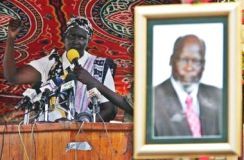John Garang buried with promises to pursue his dream of peace
By RODRIQUE NGOWI
JUBA, Sudan, Aug 6, 2005 (AP) — Dinka tribal chiefs sacrificed two strong, white bulls Saturday in a traditional display of respect after friends and former enemies buried southern leader John Garang de Mabior on a hilltop here Saturday, vowing that Sudan’s peace efforts had not died with him.

|
|
Rebecca Nyandeng, the widow of late SPLM leader John Garang, addresses mourners during the funeral service in Juba, southern Sudan, August 6, 2005. (Reuters). |
Shortly after the burial, thousands of people who had watched from afar rushed to the tomb, weeping and singing out, “Never surrender, never surrender!” Rain began to fall and a rainbow was visible on the horizon.
“It’s a sign of blessing when you bury someone and it rains,” said a thoughtful Brig. Gen. Malmal Majok, a close Garang aide and one of the pallbearers, standing near the tomb.
Earlier, the two-hour funeral service at All Saint’s Cathedral in Juba, the planned capital of the autonomous southern Sudan, was filled with praise for Garang’s leadership and promises to push forward with the Comprehensive Peace Agreement, a landmark deal meant to achieve his dream of a peaceful, unified Sudan.
“Dr. John wanted you to be united,” his widow, Rebecca, told the tens of thousands of mourners. “I will not miss my husband as long as you, the people of Sudan, are the watchdogs of the CPA.”
Women in the audience cheered and ululated in response to her words. A choir dressed all in black sang mournful songs, their hands on their heads in grief.
The death of the former southern rebel leader Garang has raised fears about the January peace deal he struck with longtime enemy President Omar al-Bashir bringing to an end the 21-year civil war between the south _ where most are Christian and animist ethnic Africans — and the mostly Muslim Arab north.
His charismatic — and sometimes strong-handed — leadership had been seen as essential to making the agreement work. On July 9, he took up the post of first vice president under al-Bashir, the first step in the formation of a power-sharing government between north and south.
His death in a July 30 helicopter crash in southern Sudan set off days of violent clashes in Khartoum and other cities — including Juba.
At Saturday’s ceremonies, President Omar al-Bashir and Salva Kiir Mayardit, who succeeded Garang as leader of the Sudan People’s Liberation Movement, promised Rebecca Garang that they would continue moving toward peace.
“War has many heroes, but the heroes of peace are few. Garang is a hero of peace,” al-Bashir said. “To mother Rebecca we say there will be no return to war. … We are moving toward a new Sudan full of hope for all of its people.”
He called Kiir to the podium and clasped his hand high in the air, a gesture identical to the one he made with Garang at his inauguration just four weeks ago.
Perhaps the most poignant moments of the ceremony came when two of Garang’s children spoke. His eldest son Mabior, a tall, thin young man dressed in SPLA fatigues and a beret, called his father a courageous man and told the southerners that he and his father admired them.
“All we can do is ensure that the memory of my father and our leader is as strong and as phenomenal as his life,” Garang’s daughter, Akoul, said.
Hoping to put down suspicions among some southerners that Garang was intentionally killed, the government and SPLM quickly stated that the crash, which killed 12 other people, was an accident and initiated an investigation, bringing in the United Nations, Uganda and Kenya for assistance. The U.S. National Transportation Safety Board announced Saturday a team of its investigators would also help.
The helicopter’s black box has been found but not yet removed from the site pending the arrival of investigators Monday.
Garang was flying in a helicopter of Ugandan President Yoweri Museveni, his close friend whom he had been visiting in northern Uganda. Museveni angered Sudanese officials on Friday when he suggested possible causes of the crash.
“It may be an accident, it may be something else,” Museveni said. “Either the pilot panicked, either there was some side wind or the instruments failed or there was an external factor.”
The Sudanese government responded angrily, saying that raising possibilities of the cause would only damage the investigation.
“We hope that all parties, especially Uganda, would stop issuing statements which are not based on facts,” Information Minister Abdel-Basit Sabdera told the official Sudan News Agency.
Apparently seeking to avoid confrontations at the funeral, Museveni changed his plans at the last minute and sent his defense minister to represent Uganda.
The leaders of South Africa, Kenya, Ethiopia and Tanzania attended the funeral, as did the head of the Arab League and the U.N. special representative to Sudan. Arab and other countries, including Norway, also sent delegates. The United States was represented by Andrew Natsios, head of USAID.
In the days before the funeral, Garang’s body was flown from town to town in the south to give people a chance to pay last respects to their hero. The final stop was Juba, a strategic town in the civil war that was never held by the SPLM, and is to be the capital of south Sudan.
Hundreds of SPLM supporters flew in for the funeral, as did church leaders of various denominations from across Sudan.
Episcopalian Archbishop Joseph Bringi Marona observed that Garang fought as a rebel leader for 21 years and served as vice president for just 21 days.
“Go in peace, rest in peace and may God bless you,” he said to his deceased friend.
